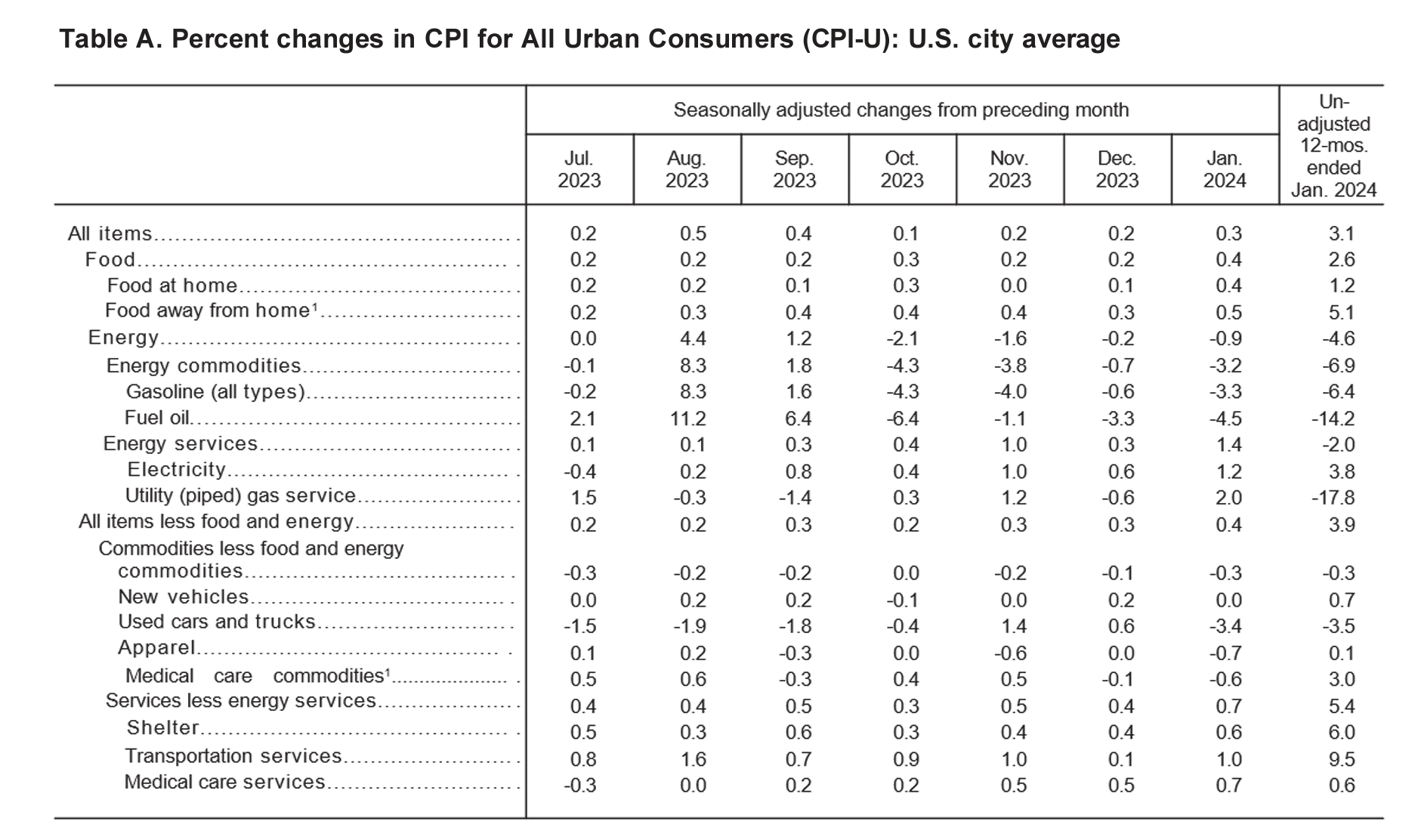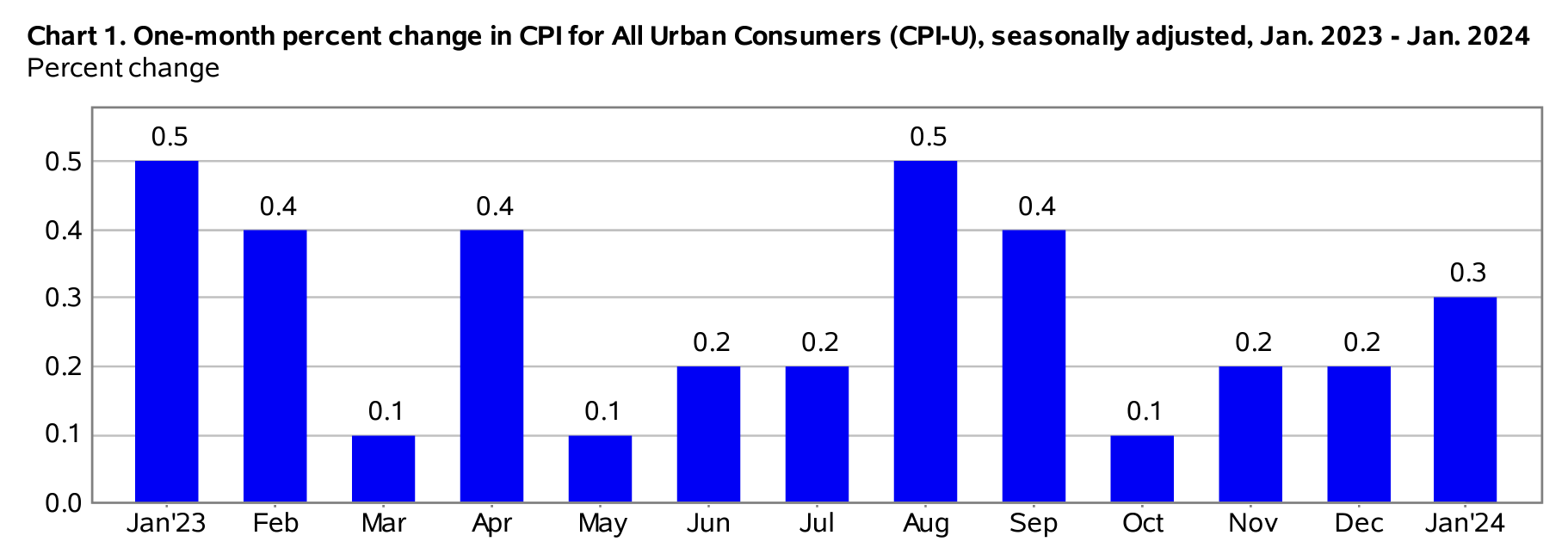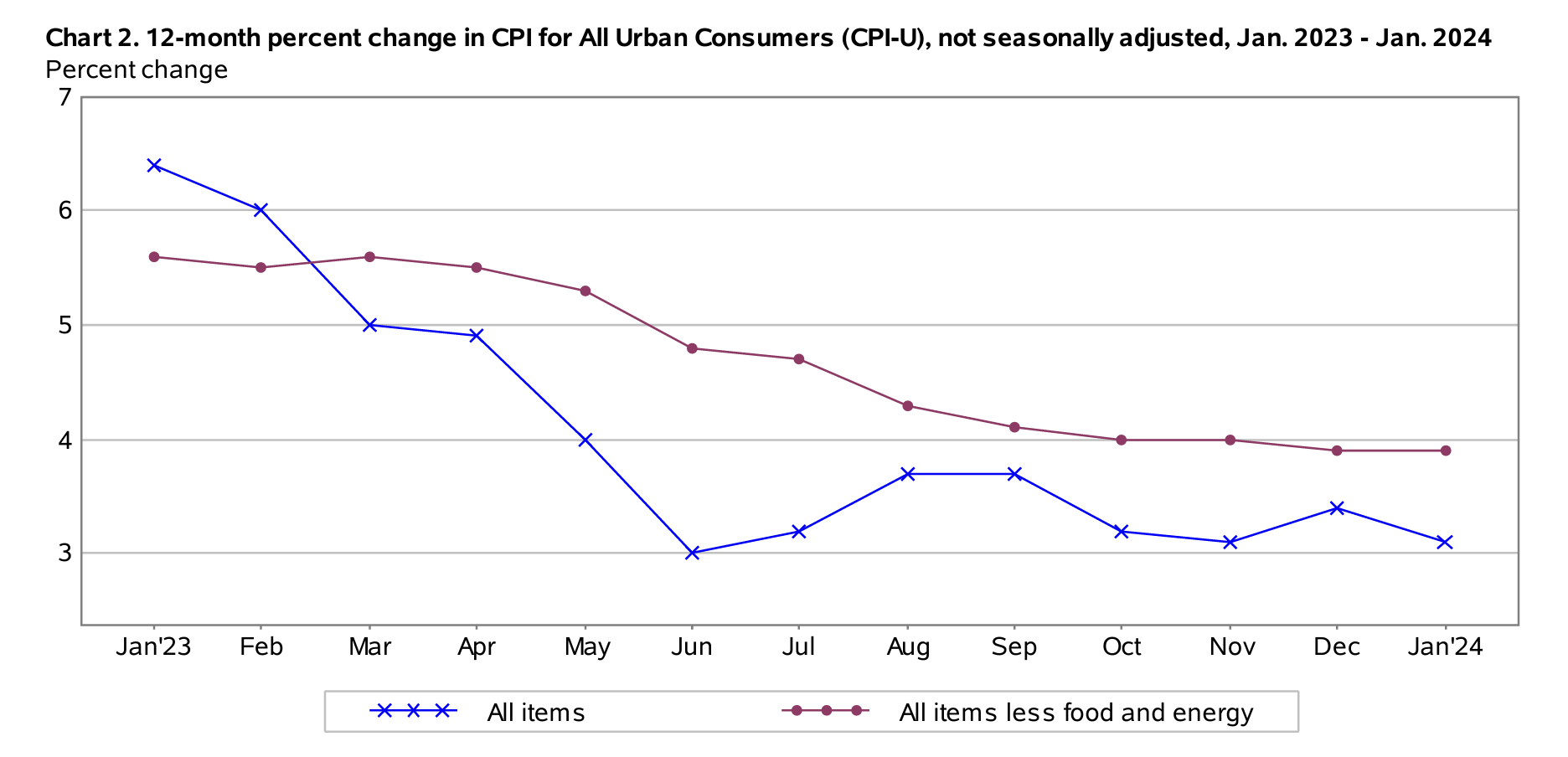The January 2024 Consumer Price Index of All Urban Consumers (CPI-U) report indicates that inflation rose by 0.3% for the month, matching the same level of price acceleration seen in December and rising sharply from November’s more modest increase (+0.1%). These data were released at 8:30 am EST on Tuesday, February 13, 2024, by the Bureau of Labor Statistics. Before seasonal adjustment, the year-over-year (Y-o-Y) inflation rate in the all-items index grew by 3.1%, marking a notable deceleration from December’s 3.4% CPI reading.
This month’s CPI read came in hotter than expected. According to Barron’s, the economic consensus in advance of Tuesday’s CPI report forecasted a Y-o-Y price growth of 2.9%. Now that we have seen two consecutive months exceed forecasted inflation, market watchers are right to question whether this will delay any interest rate cuts by Q2 2024. With today’s news, any potential rate cuts are likely to be delayed given that last month’s inflation spike appears not to be an anomaly.
The current Fed interest rate sits at 5.5%, a 22-year high, and borrowers and investors alike are hotly anticipating interest rate relief as inflation comes under control. However, this month’s CPI report suggests that relief may be further away than originally thought.
Reactions were universally negative in the stock market in response to today’s inflation news. As of noon EST, the Dow Jones Industrial Average was down more than 400 points. European markets also closed in the red.
This month’s inflation rise was fueled in large part by rising food and housing prices, as has been the case over the previous two months. Food and energy costs tend to be volatile relative to other consumer goods. Excluding these items from the CPI, core prices rose only 0.4% month-over-month, up from December’s 0.3% increase.
Unlike last month, core CPI prices rose in January, casting even greater doubt on whether the Fed’s target inflation rate of 2% is attainable in the foreseeable future. Both headline and core inflation remain higher than both the Fed and everyday Americans would like, suggesting that the “last mile” of fighting inflation will likely be more difficult than anticipated.
Source: Bureau of Labor Statistics
Food Prices
The food index rose by 0.4 percent in December, increasing by twice the margin seen in December (+0.2%). The index for food at home rose by 0.4 percent, also up considerably from December. Food away from home fared worse, up 0.5 percent on the month. Notably, the index for meats, poultry, eggs, and fish was unchanged from December, while nonalcoholic beverages rose by 1.2 percent. On a Y-o-Y basis, the food at home index rose by 1.2 percent, slightly down from December (1.3%), and the food away from home index rose by 5.1 percent on the year.
Energy Prices
Lower energy costs were the main price category that pulled inflation down in December. The energy index fell 0.9 percent in January following a modest acceleration in the previous month, continuing a downtrend seen since October but interrupted last month due to base year effects. The natural gas index plummeted 17.8 percent over the year, and the energy index as a whole fell by 4.6 percent Y-o-Y. Fortunately for consumers, the gasoline index dropped by 6.4 percent Y-o-Y, and the fuel oil index dropped 14.2 percent.
Core January 2024 CPI
Regarding the core CPI data for January 2024 (i.e., inflation less food and energy), the index rose 0.4 percent month-over-month, accelerating over the 0.3 percent margin seen in both December and November. However, the index rose by 3.9 percent on a Y-o-Y basis, matching December’s gain. Below is an itemized breakdown of the main price fluctuations seen in January’s core CPI reading:
- Shelter index: (+0.6%) [December: +0.5%]
- Rent index: (+0.4%) [December: +0.4%]
- Owners’ equivalent rent: (+0.6%)
- Motor vehicle insurance: (+1.4%) [December: +1.5%]
- Medical care index: (+0.5%) [December: +0.6%]
- Used cars and trucks: (-3.4%) [December: +0.5%]
- Apparel: (-0.7%)
- Hospital services: (+1.6%)
Source: Bureau of Labor Statistics
Seasonally Unadjusted CPI Data for January 2024
Before seasonal adjustments, the CPI-U for January 2023 increased (+3.1%) year-over-year, rising to an index level of 308.417. Since these figures are unadjusted, they include regular seasonal price fluctuations that generally occur by the same margins every year.
Source: Bureau of Labor Statistics
While Inflation Holds Strong, So Too Does Gold
While the pundit class decries the difficulties of “last mile” inflation, there is little indication that the Fed’s target rate of 2% is achievable within the first half of 2024. An increasing chorus of economists are now looking to the summer as the most likely time frame for any potential rate cut, if that.
Meanwhile, American households are suffering. High inflation has significantly reduced the purchasing power of American families over the past two years, with rising healthcare costs leading the way. Despite strong job growth, Americans aren’t feeling any relief. The long-lasting effects of inflation have left a lasting mark on everyday consumers, with about 75% of Americans describing the economy as “poor”.
The silver lining is that there are well-performing assets that may provide relief for American investors. In December, the spot price of gold broke its all-time high, hitting $2,135 per ounce before stabilizing around the $2,000 mark. Bitcoin and Ethereum, riding on the launch of widely-anticipated cryptocurrency ETFs, have also rallied in double digits over the past few months and are currently trading at multi-year highs.
Previous recessions and market shocks have shown that gold and silver can outperform traditional securities when financial markets decline. For many investors, gold acts as a reliable hedge against inflation, offering a stable store of value when others are not. Investing in gold and silver can serve as a protective measure for your savings against the devaluation of the U.S. dollar, allowing you to preserve your wealth during times of inflation.
Thinking about diversifying your portfolio with gold or silver? You can take the first step by opening an account with one of the top-rated gold IRA service providers. In the meantime, you can use our complimentary CPI inflation calculator tool to monitor how inflation is impacting your household’s bottom line. As always, consult with a financial advisor before investing in any asset.






